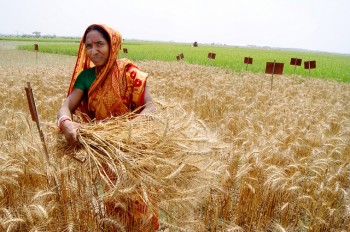Nutrition, health and food security
As staple foods, maize and wheat provide vital nutrients and health benefits, making up close to two-thirds of the world’s food energy intake, and contributing 55 to 70 percent of the total calories in the diets of people living in developing countries, according to the U.N. Food and Agriculture Organization. CIMMYT scientists tackle food insecurity through improved nutrient-rich, high-yielding varieties and sustainable agronomic practices, ensuring that those who most depend on agriculture have enough to make a living and feed their families. The U.N. projects that the global population will increase to more than 9 billion people by 2050, which means that the successes and failures of wheat and maize farmers will continue to have a crucial impact on food security. Findings by the Intergovernmental Panel on Climate Change, which show heat waves could occur more often and mean global surface temperatures could rise by up to 5 degrees Celsius throughout the century, indicate that increasing yield alone will be insufficient to meet future demand for food.
Achieving widespread food and nutritional security for the world’s poorest people is more complex than simply boosting production. Biofortification of maize and wheat helps increase the vitamins and minerals in these key crops. CIMMYT helps families grow and eat provitamin A enriched maize, zinc-enhanced maize and wheat varieties, and quality protein maize. CIMMYT also works on improving food health and safety, by reducing mycotoxin levels in the global food chain. Mycotoxins are produced by fungi that colonize in food crops, and cause health problems or even death in humans or animals. Worldwide, CIMMYT helps train food processors to reduce fungal contamination in maize, and promotes affordable technologies and training to detect mycotoxins and reduce exposure.
Tackling wheat rust diseases requires $108 million a year, study shows
 Nutrition, health and food security
Nutrition, health and food security
Despite efforts to develop wheat resistant to stem, stripe and leaf rusts, the diseases will continue to thwart scientists, making ongoing funding vital, a top economist has said.
Zero-till wheat raises farmers’ incomes in eastern India, research shows
 Climate adaptation and mitigation
Climate adaptation and mitigation
Rebuilding livelihoods: CIMMYT supports agricultural recovery in Nepal
 Climate adaptation and mitigation
Climate adaptation and mitigation
The world’s largest maize ear contest 2015
 Nutrition, health and food security
Nutrition, health and food security
Scientist Denise Costich describes her experience as a judge in the contest to find “The World’s Largest Maize Ear” held in Jala, Nayarit, Mexico.
Why GM wheat may be the key to stave off world hunger
 Nutrition, health and food security
Nutrition, health and food security
Unless global policymakers redouble their efforts to properly support a strategy to ensure a future food supply, the current hunger crisis threatens only to get worse.
CGIAR open letter to the heads of state attending the 70th UN General Assembly
 Climate adaptation and mitigation
Climate adaptation and mitigation
Martin Kropff and John Snape joined leaders from CGIAR centers worldwide in an open letter to the heads of state at the 70th UN General Assembly in New York.
Replacing gender myths and assumptions with knowledge
 Gender equality, youth and social inclusion
Gender equality, youth and social inclusion
If we are to be truly successful in improving the lives of farmers and consumers in the developing world, we need to base our interventions on the best evidence available.
The first heat tolerant maize hybrids are licensed for deployment in Bangladesh, India and Nepal
 Climate adaptation and mitigation
Climate adaptation and mitigation
Value of CGIAR wheat estimated at up to $3.8 billion a year, research shows
 Innovations
Innovations
Wheat bred by the CGIAR consortium of agricultural researchers has a huge global reach.
A ‘double-hatted’ maize variety brings good tidings to farmers in western Kenya
 Climate adaptation and mitigation
Climate adaptation and mitigation
